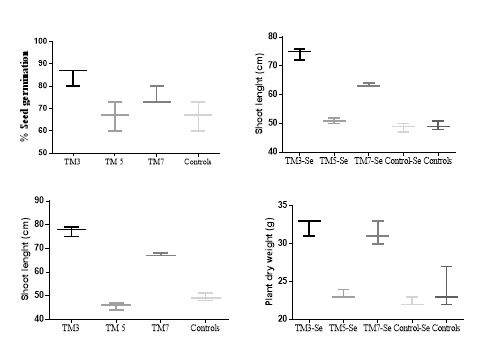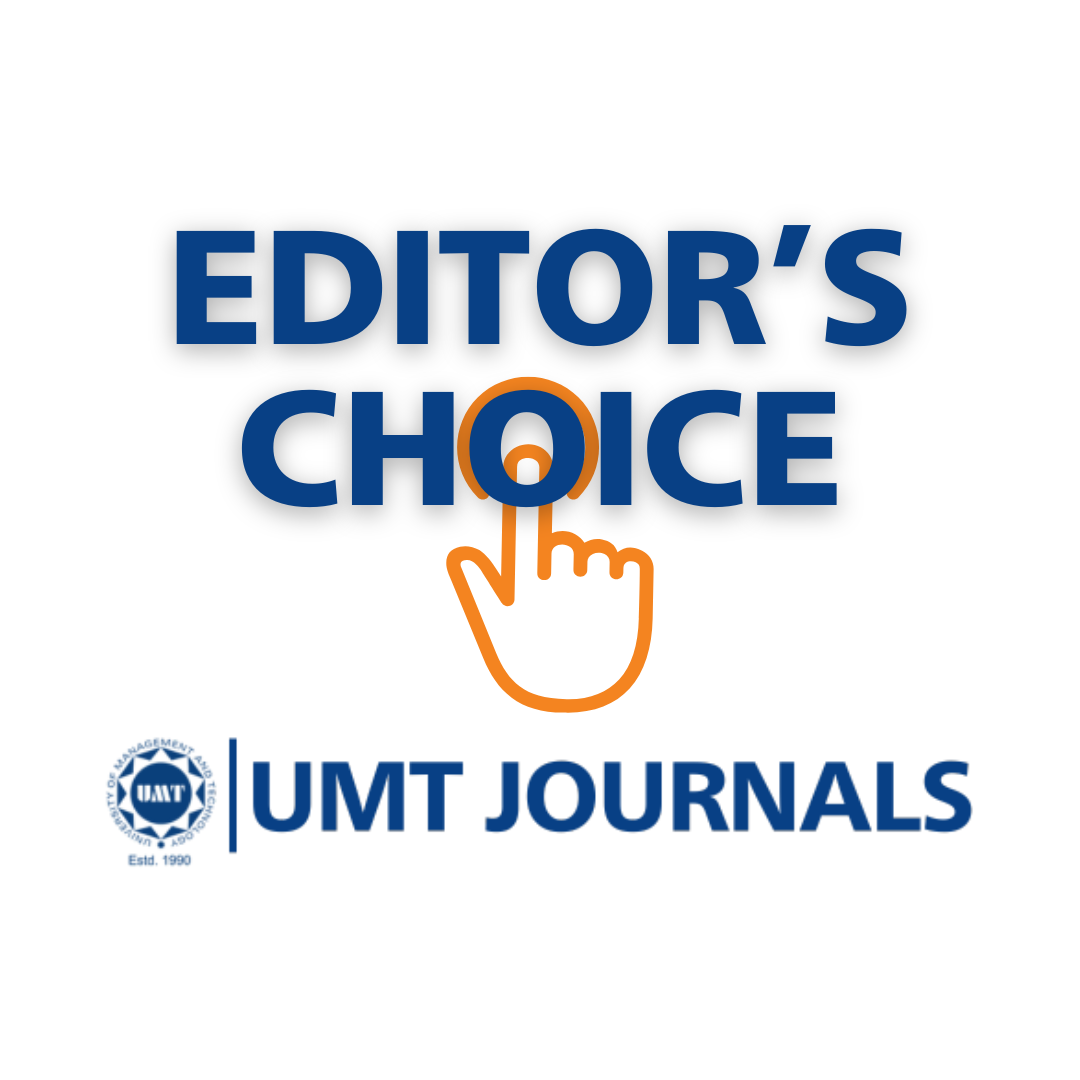Selenium Resistant Bacilli and Pseudomonas as Potential Candidate for Selenium and Iron Biofortification in Maize Plants
Abstract
 Abstract Views: 277
Abstract Views: 277
Selenium is an essential element and is required in minute quantities for performing vital functions in living cells. Food is the ultimate source of selenium for animal and human populations. Crops, such as maize, which are used as food and feed, can be biofortified with selenium to alleviate selenium deficiency in both populations. The current study was conducted to isolate selenium-resistant bacteria from soil samples. Isolated bacteria were characterized on a morphological and biochemical basis. For specie level classification, 16S rRNA sequences were obtained. Isolated strains belonged to Bacillus halotolerans (TM3),Pseudomonas protegens (TM5), and Bacillus endophyticus (TM7). In-vitro PGPB characterization showed that some of the strains can produce IAA, Ammonia, HCN, and phosphate solubilization enzymes. Greenhouse pot experiments showed that the isolates enhanced seed germination rate, shoot length, and plant dry weight. Selenium supplementation caused decreased growth, but its effect was mitigated by the inoculation of isolated bacteria. Inoculation of these bacteria enhanced selenium content in maize leaves and shoots, ranging from 6-7%, while the addition of selenium to the soil increased selenium content by 300%. The iron content of maize leaves was also increased up to 17% in the inoculated strains.
Downloads
References
Chavatte L. Seleno-proteins. New York: Springer; 2018.
Suttle NF. Mineral nutrition of livestock. Cabi; 2010.
Camaschella C. Iron deficiency. Blood, Am J Hematol. 2019;133(1):3039. https://doi.org/10.1182/blood2018-05-815944
Wysocka D., Snarska A., Sobiech P. Iron in cattle health. J Elem. 2020;25(3):1175-1185. https://doi.org/10.5601/jelem.2020.25.2.1960
Statista. Worldwide Production of Grain in 2020/21. https://www.statista. com/statistics/263977/world grainproduction-by-type/.
Pakistan Go. Economic Survey of Pakistan, Ministry of food, Agriculture (Federal Bureau of Statistics), Islamabad. 2021:17-43. https://www. pc.gov.pk/uploads/cpec/PES_2020_21 .pdf
Lin Z-Q. Uptake and accumulation of selenium in plants in relation to chemical speciation and biotransformation. Development and uses of biofortified agricultural products. Boca Raton: CRC Press; 2008:63 74.
Thavarajah P, Sarker A, Materne M, et al. A global survey of effects of genotype and environment on selenium concentration in lentils (Lens culinaris L.): Implications for nutritional fortification strategies. Food Chem. 2011;125(1):72-76. https://doi.org/10.1016/j.foodchem.20 10.08.038
Watts C, Aslam M, Gunaratna N, Shankar A, Groote HD, Sharp P. Agronomic Biofortification of maize with zinc fertilizers increases zinc uptake from maize flour by human intestinal caco-2 cells. Curr Dev Nutr. 2020;4(Supplement_2):1853-1853. https://doi.org/10.1093/cdn/nzaa067_ 080 0.
Ngigi PB, Lachat C, Masinde PW, Du Laing G. Agronomic biofortification of maize and beans in Kenya through selenium fertilization. Environ Geochem Health. 2019;41(6):25772591. https://doi.org/10.1007/s10653019-00309-
Maqbool MA, Aslam M, Beshir A, Khan MS. Breeding for provitamin A biofortification of maize (Zea mays L.). Plant Breed. 2018;137(4):451469.https://doi.org/10.1111/pbr.12618
Kumar N, Salakinkop S. Agronomic biofortification of maize with zinc and iron micronutrients. Mod Concepts Dev Agron. 2018;1(5):2-5.
Shameer S, Prasad T. Plant growth promoting rhizobacteria for sustainable agricultural practices with special reference to biotic and abiotic stresses. Plant Growth Regul. 2018;84(3):603-615. https://doi.org/10.1007/s10725017-0365-1
Rahman M, Sabir AA, Mukta JA, et al. Plant probiotic bacteria Bacillus and Paraburkholderia improve growth, yield and content of antioxidants in strawberry fruit. Sci Rep. 2018;8(1):1 55. https://doi.org/10.1038/s4159801820235-1
Sun Z, Yue Z, Liu H, Ma K, Li C. Microbial-assisted wheat iron biofortification using endophytic Bacillus altitudinis WR10. Fron Nutr. 2021;8:476. https://doi.org/10.3389/ fnut.2021.704030
Trivedi G, Patel P, Saraf M. Synergistic effect of endophytic selenobacteria on biofortification and growth of Glycine max under drought stress. S Afr J Bot. 2020;134:27-35. https://doi.org/10.1016/j.sajb.2019.10. 001
Saitou N, Nei M. The neighbor-joining method: a new method for reconstructing phylogenetic trees. Mol Biol Evol. 1987;4(4):406-425. https://doi.org/10.1093/oxfordjournals .molbev.a040454
Kumar S, Stecher G, Li M, Knyaz C, Tamura K. MEGA X: molecular evolutionary genetics analysis across
computing platforms. Mol Biol Evol. 2018;35(6):1547. https://doi.org/10. 1093/molbev/msy096
Patten CL, Glick BR. Role of Pseudomonas putida indoleacetic acid in development of the host plant root system. Appl Environ Microbiol. 2002;68(8):3795-3801. https://doi.org/ 10.1128/AEM.68.8.3795-3801.2002
Gaur A. Phosphate solubilizing microorganisms as biofertilizer. Omega Scientific Publishers; 1990.
James C, Natalie S. Microbiology. A laboratory manual. Pearson Education; 2014.
Lorck H. Production of hydrocyanic acid by bacteria. Physiol Plant. 1948;1(2):142-146. https://doi.org/10.1111/j.1399-3054.1948.tb07118.x
Yasin M, El-Mehdawi AF, Pilon-Smits EA, Faisal M. Selenium-fortified wheat: potential of microbes for biofortification of selenium and other essential nutrients. Int J Phytoremediation. 2015;17(8):777786. https://doi.org/10.1080/ 15226514.2014.987372
Mehdi Y, Dufrasne I. Selenium in cattle: a review. Mol. 2016;21(4):545. https://doi.org/10.3390/molecules210 40545
Dokoupilová A, Marounek M, Skřivanová V, Březina P. Selenium content in tissues and meat quality in rabbits fed selenium yeast. Czech J Anim Sci. 2007;52(6):165-169. https://doi.org/10.17221/2319-CJAS
Liu S, Sun H, Jose C, et al. Phenotypic blood glutathione concentration and selenium supplementation interactions on meat colour stability and fatty acid concentrations in Merino lambs Meat Sci. 2011;87(2):130-139. https://doi.org/10.1016/j.meatsci.2010 .09.011
Zuma MK, Kolanisi U, Modi AT. The potential of integrating provitamin Abiofortified maize in smallholder farming systems to reduce malnourishment in South Africa. Int J Environ Res. 2018;15(4):805. https://doi.org/10.3390/ijerph1504080 5
Gunaratna NS, Moges D, De Groote H. Biofortified maize can improve quality protein intakes among young children in southern Ethiopia. Nutr. 2019;11(1):192. https://doi.org/10. 3390/nu11010192
Alshehrei F. Production of polyhydroxybutyrate (PHB) by bacteria isolated from soil of Saudi Arabia. J Pure Appl Micro. 2019;13(2):897-904. https://dx.doi. org/10.22207/JPAM.13.2.26
Zhang K, Xue Y, Xu H, Yao Y. Lead removal by phosphate solubilizing bacteria isolated from soil through biomineralization. Chemosphere. 2019;224:272-279. https://doi.org/ 10.1016/j.chemosphere.2019.02.140
Yasmin R, Hussain S, Rasool MH, Siddique MH, Muzammil S. Isolation, characterization of Zn solubilizing bacterium (Pseudomonas protegens RY2) and its contribution in growth of chickpea (Cicer arietinum L) as deciphered by improved growth parameters and Zn content. DoseResponse. 2021;19(3):1-2. https://doi.org/10.1177/15593258211036791
Zhang Z, Yin L, Li X, Zhang C, Liu C, Wu Z. The complete genome sequence of Bacillus halotolerans ZB201702 isolated from a drought-and saltstressed rhizosphere soil. Microb Pathog. 2018;123:246-249. https://doi.org/10.1016/j.micpath.2018 .07.019
Das R, Udayakumar P, Vaidyanathan R. A study on enhanced production of 3-demethylated colchicine by a novel strain of Bacillus endophyticus isolated from rhizospheric soils of Gloriosa superba. Biocatal Biotransformation. 2021;39(3):198-205. https://doi.org/10.1080/10242422.2020.1808628
Ghosh A, Mohod AM, Paknikar KM, Jain RK. Isolation and characterization of selenite-and selenate-tolerant microorganisms from seleniumcontaminated sites. World J Microbiol Biotechnol. 2008;24(8):1607-1611. https://doi.org/10.1007/s11274-0079624-z
Lusa M, Help H, Honkanen A-P, et al. The reduction of selenium (IV) by boreal Pseudomonas sp. strain T5-6-I– Effects on selenium (IV) uptake in Brassica oleracea. Environ Res. 2019;177. nhttps://doi.org/10.1016/j.envres.2019.108642
Wang D, Rensing C, Zheng S. Microbial reduction and resistance to selenium: Mechanisms, applications and prospects. J Hazard Mater. 2022;421. https://doi.org/10.1016/j.jhazmat.2021.126684
Khan MA, Asaf S, Khan AL, et al. Thermotolerance effect of plant growth-promoting Bacillus cereus SA1 on soybean during heat stress. BMC Microbiol. 2020;20(1):1-14. https://doi.org/10.1186/s12866-02001822-7
Hashem A, Tabassum B, Abd_Allah EF. Bacillus subtilis: A plant-growth promoting rhizobacterium that also impacts biotic stress. Saudi J Biol Sci. 2019;26(6):1291-1297. https://doi.org/10.1016/j.sjbs.2019.05. 004
Chitara MK, Chauhan S, Singh RP. Bioremediation of Polluted Soil by Using Plant Growth–Promoting
Selenium Resistant Bacilli … Rhizobacteria. Microbial Rej of Pol Environ. Springer; 2021;25:203-226. https://doi.org/10.1007/978-981-157447-4_8
Zhang M, Yang L, Hao R, Bai X, Wang Y, Yu X. Drought-tolerant plant growth-promoting rhizobacteria isolated from jujube (Ziziphus jujuba) and their potential to enhance drought tolerance. Plant Soil. 2020;452(1):423-440. https://doi.org/10.1007/s11104-020-04582-5
Durán P, Acuña JJ, Jorquera MA, et al. Endophytic bacteria from seleniumsupplemented wheat plants could be useful for plant-growth promotion, biofortification and Gaeumannomyces graminis biocontrol in wheat production. Biol Fertil Soils. 2014;50(6):983-990. https://doi.org/10.1007/s00374-0140920-0
Kaur T, Vashisht A, Prakash NT, Reddy MS. Role of Selenium-Tolerant Fungi on Plant Growth Promotion and Selenium Accumulation of Maize Plants Grown in Seleniferous Soils. Water Air Soil Pollut. 2022;233(1):112. https://doi.org/10.1007/s11270021-05490-9
Nakamaru YM, Altansuvd J. Speciation and bioavailability of selenium and antimony in non-flooded and wetland soils: A review. Chemosphere. 2014;111:366-371. https://doi.org/10.1016/j.chemosphere .2014.04.024
De Feudis M, D'Amato R, Businelli D, Guiducci M. Fate of selenium in soil: A case study in a maize (Zea mays L.) field under two irrigation regimes and fertilized with sodium selenite. Sci Total Environ.. 2019;659:131-139. https://doi.org/10.1016/j.scitotenv.201 8.12.200
Gupta M, Gupta S. An overview of selenium uptake, metabolism, and toxicity in plants. Front Plant Sci.. 2017;7:2074. https://doi.org/10.3389/ fpls.2016.02074
Chauhan R, Awasthi S, Tripathi P, et al. Selenite modulates the level of phenolics and nutrient element to alleviate the toxicity of arsenite in rice (Oryza sativa L.). Ecotoxicol Environ Saf. 2017;138:47-55. https://doi.org/10.1016/j.ecoenv.2016.11.015
Fang Y, Wang L, Xin Z, Zhao L, An X, Hu Q. Effect of foliar application of zinc, selenium, and iron fertilizers on nutrients concentration and yield of rice grain in China. J Agric Food Chem. 2008;56(6):2079-2084. https://doi.org/10.1021/jf800150z
Mishra PK, Bisht SC, Ruwari P, et al. Bioassociative effect of cold tolerant Pseudomonas spp. and Rhizobium leguminosarum-PR1 on iron acquisition, nutrient uptake and growth of lentil (Lens culinaris L.). Eur J Soil Biol. 2011;47(1):35-43. https://doi.org/10.1016/j.ejsobi.2010.1 1.005
Khalid S, Asghar HN, Akhtar MJ, Aslam A, Zahir ZA. Biofortification of iron in chickpea by plant growth promoting rhizobacteria. Pak J Bot. 2015;47(3):1191-1194.

Copyright (c) 2022 Zain ul Abadin , Muhammad Faisal

This work is licensed under a Creative Commons Attribution 4.0 International License.
BSR follows an open-access publishing policy and full text of all published articles is available free, immediately upon publication of an issue. The journal’s contents are published and distributed under the terms of the Creative Commons Attribution 4.0 International (CC-BY 4.0) license. Thus, the work submitted to the journal implies that it is original, unpublished work of the authors (neither published previously nor accepted/under consideration for publication elsewhere). On acceptance of a manuscript for publication, a corresponding author on the behalf of all co-authors of the manuscript will sign and submit a completed the Copyright and Author Consent Form.









